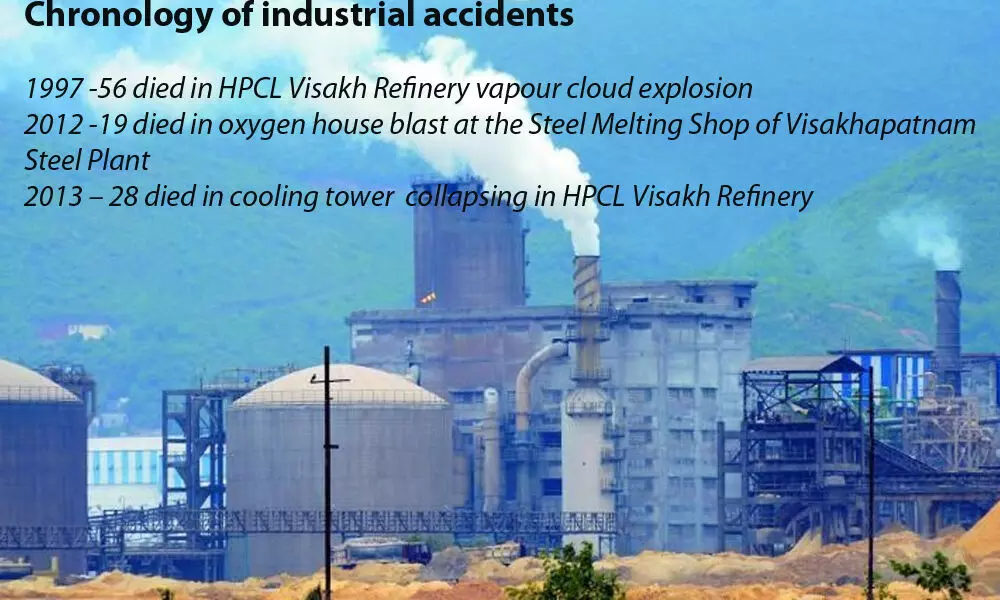Mishaps tarnish image of Vizag as industrial hub
Jawaharlal Nehru Pharma City, units at Hetero Drugs, Divi’s Lab and others have also been experiencing some accident or the other
image for illustrative purpose

Visakhapatnam 'DESTINATION VIZAG,' the high profile campaign to enhance the brand image of Visakhapatnam, the proposed executive capital of Andhra Pradesh with a robust industrial base, has suffered a setback due to poor status in developing a safety apparatus.
Ever since the first major disaster in the undivided State occurred in 1997 at HPCL Visakh Refinery claiming at least 56 people following vapour cloud explosion, it appears to have become a ritual for one industrial unit or the other in recording a fatal accident.
Visakhapatnam, Srikakulam and Vizianagaram stretch of North Andhra over the years has also emerged as the largest pharma cluster after the Hyderabad region in the two Telugu-speaking States with pharma units with an estimated turnover of over Rs 50,000 crore.
After 1997, HPCL Visakh Refinery recorded another catastrophe with the collapsing of a cooling tower killing 28 in August, 2013. This was preceded by an oxygen house blast at the Steel Melting Shop of Visakhapatnam Steel Plant in June, 2012, which claimed 19 employees including several officials of General Manager and Deputy General Manager rank.
The recent blast at the Crude Distillation Unit-3 of HPCL Visakh Refinery would have become a major catastrophe had the fire fighting personnel not mobilised from various neighbouring industries, District Fire Brigade and Indian Navy to extinguish the flames emanating from the CDU in a record time and preventing its spread to other critical facilities. The timely action prevented any casualty.
Jawaharlal Nehru Pharma City, units at Hetero Drugs, Divi's Lab and others have also been experiencing some accident or the other. Release of poisonous gases and indiscriminate dumping of untreated effluents have become issues of concern for the residents of the region.
LG Chem belonging to LG Polymers, a Korean company was in news a year ago for leakage from the styrene monomer tank leading to death of 11 and injuries to at least 300 people. This led to imposition of heavy penalties and criminal prosecution of the management and shut down of the unit till further orders by National Green Tribunal and courts.
The problem with the city, the largest industrial hub and cosmopolitan city in AP with a population of three million in Visakhapatnam Metropolitan Region Development Authority (VMRDA) limits, is that it does not have an escape route in the event of a major industrial tragedy as it has a spoon-shaped topography. The city is surrounded by sea on three sides and hills on one side leaving no scope to run away to safety if a major disaster happens.
"Vizag and its surroundings have become a haven for Bhopal-like industrial accidents that endanger the lives of the industrial workers and the civilians. The reason for this is that the State Government has not cared to learn lessons from the past accidents and has failed to enforce regulation under the Factories Act, the laws applicable to hazardous chemical industries," remarked noted social activist and former IAS officer EAS Sarma.
He told Bizz Buzz on Wednesday that the latest fire at Visakh Refinery is a repetition of several similar accidents at HPCL itself and several other accidents at Pharma City, Hetero Drugs, LG Polymers, Deccan Chemicals near Payakaraopeta and so on. In the specific case of LG Polymers, a high-powered committee of the State Government had recommended a comprehensive safety audit of all hazardous industries but, till date, no such audit has taken place.
He further said: "the Factories Act was amended after the Bhopal accident to prevent similar accidents. But the Inspectorate of Factories of the State Government has been callous in not enforcing the same by periodic and surprise inspections and by not exercising surveillance over industrial safety. Not a single senior officer of that department has so far been proceeded against."
In the specific case of HPCL, there is an Oil Industry Safety Directorate (OISD) under the Union Ministry of Petroleum (MOP) which is responsible for overseeing the safety of all oil installations. One wonders whether MOP and OISD have exercised due diligence in ensuring safety at HPCL and whether they have ensured HPCL's compliance with the findings of the expert committees in the past on the series of accidents that took place at the refinery. Considering that a large number of ONGC's employees have lost their lives recently when their barge capsized in the Arbian Sea raises serious concerns about the ability of MOP and OISD in ensuring industrial safety in the petroleum sector.
Sarma pointed out that HPCL is also to be blamed for causing air pollution in Vizag and it shows the failure of its top management in industrial safety and prevention of pollution. APPCB is to be equally found at fault.
A senior government doctor said since several public sector units are located in the city, the Centre should take up the moral responsibility for bringing industrial pollution and accidents under check.


